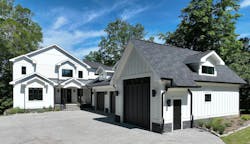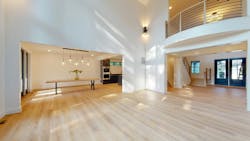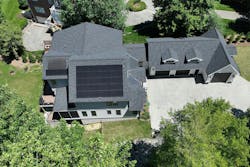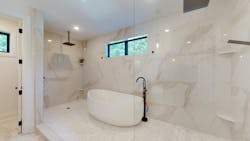Award-Winning Healthy Homes With Clean Air and Energy
This month, the US Department of Energy named Healthy Communities a winner of the Housing Innovation Awards, which recognize the leading edge of zero energy ready homebuilders. It’s a familiar honor for the Virginia-based builder: Healthy Communities has snagged a Housing Innovation Award every year since 2016. (In October, the DOE will announce the grand winners at the EEBA High Performance Home Builder Summit in Salt Lake City.)
This year’s honor goes to a custom home called the Ridge in Williamsburg, Va. The Ridge represents a bit of an outlier for Healthy Communities: While the builder has constructed energy-efficient, high-performance homes for the past decade, it has built just a handful of custom homes in recent years.
But for the Ridge, Healthy Communities had a particularly interested customer: company president Morgan Epstein Wojciechowski, who’s also the daughter of company chair Jay Epstein.
All-Electric Healthy Homes
The all-electric Ridge is so energy efficient, Jay Epstein explains, that its utility bills cost just about $1,000 per year—for a 5,400-sf home. With rooftop solar, the Ridge has earned a Pearl Platinum certification for its energy efficiency and high performance, and it also has achieved a HERS Index Score of 15. (With HERS, the lower the score, the more efficient the home, so 0 indicates a net-zero home that produces as much energy through renewable sources as it consumes.)
For the Ridge, Healthy Communities leveraged building techniques it has honed on its production homes. Like those homes, the Ridge features structured plumbing, with every water fixture no more than five feet from the insulated main hot water line. As a result, hot water can get to any fixture within 15 seconds.
The Ridge also has some features not found in the builder’s production homes. For instance, the home features a conditioned crawlspace, so there’s only a 10-degree temperature difference between the attic and living space, Epstein says. The air handling unit and energy recovery ventilator (ERV) are housed in the conditioned attic area, saving energy.
As with his other healthy homes, Epstein touts the Ridge’s indoor air quality. “When you walk into the house, you’ll notice the air quality. You’ll notice you’re not sneezing from outdoor allergens,” he says.
The Ridge achieves that level of air quality with Trane CleanEffects, a whole-home air filtration system; about two dozen Panasonic WhisperAir Repair devices, ceiling-mounted air purifiers; and Swidget devices that monitor the air quality. Plus, the bathrooms feature Panasonic WhisperGreen Select Fans whose condensation sensors help control humidity.
A National Definition for Zero Emissions
Epstein has been building efficient, all-electric homes for years, but he notes that a home’s carbon footprint can be reduced only so far if the energy powering the residence isn’t clean. With rooftop solar, his homes can participate in net metering, so that their excess electricity goes to the grid. “But what I get back from the grid could be dirty energy,” he says.
What’s the solution? Epstein points to a program offered by his region’s power company, Dominion Energy. A voluntary program, Dominion Energy Green Power enables homeowners to harness renewable energy at about 1.2 additional cents per kilowatt-hour—which Epstein says comes to about an extra $10 per month. “Energy-efficient homes can now rely on the power company’s clean energy to reduce the operational carbon footprint to zero,” Epstein says.
Moving forward, Epstein says, the push toward clean energy—and the construction of more efficient homes—will be furthered by the DOE’s recent announcement of a national definition of zero emissions buildings.
While not mandated, the new definition says a zero emissions building is powered completely by clean energy, either onsite or offsite. Also, the building should be among the most energy efficient, and it should produce no onsite greenhouse-gas emissions.
Now, Epstein says, builders can more easily achieve the criteria of a shared definition for zero emissions, and they can more affordably build and market efficient homes—without having to add a lot more features that “sometimes just add cost to the home without truly adding efficiency,” he says.
Currently, Healthy Communities’ production homes are priced in the $400,000 to $750,000 range. Under the DOE’s new definition of zero emissions buildings, Epstein says, Healthy Communities aims to build homes priced at about $300,000.




